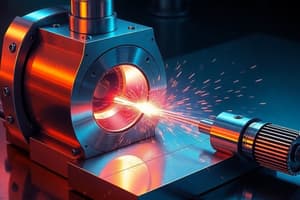Podcast
Questions and Answers
What effect does tangential velocity rise have on friction power?
What effect does tangential velocity rise have on friction power?
- Decreases friction power
- Halts friction power entirely
- Has no effect on friction power
- Leads to a rise in friction power (correct)
Why does the tool rake face soften, wear, and break under high pressure and temperature?
Why does the tool rake face soften, wear, and break under high pressure and temperature?
- Because of increased temperature rise (correct)
- Due to decreased tangential velocity
- No correlation with pressure or temperature
- Due to decreased temperature rise
What helps manufacturing engineers seek a compromise between productivity and temperature rise?
What helps manufacturing engineers seek a compromise between productivity and temperature rise?
- Decreasing cutting speed
- Increasing cutting speed (correct)
- Using low heat-resistant tool materials
- Utilizing high friction angle
How does the frictional force change with a decrease in the friction angle?
How does the frictional force change with a decrease in the friction angle?
What is needed to guard against critical diffusion or melting temperature limits at the tool-chip interface?
What is needed to guard against critical diffusion or melting temperature limits at the tool-chip interface?
What is the main purpose of seeking heat-resistant tool materials for manufacturing engineers?
What is the main purpose of seeking heat-resistant tool materials for manufacturing engineers?
What is the formula for the shear plane temperature?
What is the formula for the shear plane temperature?
What does the power term 𝑃𝑟𝑓 represent in the context of the cutting process?
What does the power term 𝑃𝑟𝑓 represent in the context of the cutting process?
How is the impulsive force 𝐹𝑖𝑚 calculated along the shear plane?
How is the impulsive force 𝐹𝑖𝑚 calculated along the shear plane?
What is the power term 𝑃𝑚𝑐 related to in the cutting process?
What is the power term 𝑃𝑚𝑐 related to in the cutting process?
In the equation 𝑃𝑠𝑚 ≈ 𝜌𝑤ℎ𝑉𝑜∆T, what does ∆T represent?
In the equation 𝑃𝑠𝑚 ≈ 𝜌𝑤ℎ𝑉𝑜∆T, what does ∆T represent?
Based on the text, how are different materials compared in terms of their resistance to cutting force?
Based on the text, how are different materials compared in terms of their resistance to cutting force?
What does the shear plane area formula represent in manufacturing science and engineering?
What does the shear plane area formula represent in manufacturing science and engineering?
In the context of manufacturing science and engineering, what is the significance of shear stress?
In the context of manufacturing science and engineering, what is the significance of shear stress?
How does shear velocity contribute to the cutting process in manufacturing?
How does shear velocity contribute to the cutting process in manufacturing?
What does the constant normal stress indicate in manufacturing science and engineering?
What does the constant normal stress indicate in manufacturing science and engineering?
How is chip compression ratio indirectly affected by the shear plane area?
How is chip compression ratio indirectly affected by the shear plane area?
What is the result of the shearing process described in the text?
What is the result of the shearing process described in the text?
How is shear displacement of planes ahead of the shear plane caused?
How is shear displacement of planes ahead of the shear plane caused?
What is the relationship between shear strain rate and the time interval of shear process?
What is the relationship between shear strain rate and the time interval of shear process?
How is shear strain rate calculated based on the text?
How is shear strain rate calculated based on the text?
What is the overall effect of plane strain conditions on the material within triangles?
What is the overall effect of plane strain conditions on the material within triangles?
How does shear velocity impact shear stress according to the text?
How does shear velocity impact shear stress according to the text?
What is the expression for the shear force on the shear plane according to the text?
What is the expression for the shear force on the shear plane according to the text?
How is the normal force on the shear plane calculated based on the provided information?
How is the normal force on the shear plane calculated based on the provided information?
In the context of cutting, what does the shear velocity relate to?
In the context of cutting, what does the shear velocity relate to?
What does the formula 𝐹𝑜 [ tan(ɸₖ) − sin(ɸₛ) ] represent according to the text?
What does the formula 𝐹𝑜 [ tan(ɸₖ) − sin(ɸₛ) ] represent according to the text?
How is the shear plane area calculated based on the information provided?
How is the shear plane area calculated based on the information provided?
What is the expression for the chip compression ratio based on the content provided?
What is the expression for the chip compression ratio based on the content provided?
What are some of the performance issues associated with a machined surface with poor texture?
What are some of the performance issues associated with a machined surface with poor texture?
What is primarily concerned with the effects of a manufacturing process below the visible surface of a machined part?
What is primarily concerned with the effects of a manufacturing process below the visible surface of a machined part?
Which zone experiences mechanical, metallurgical, chemical, thermal, and electrical alterations in metal cutting processes?
Which zone experiences mechanical, metallurgical, chemical, thermal, and electrical alterations in metal cutting processes?
Where does the instantaneous shear plane lie in metal cutting processes?
Where does the instantaneous shear plane lie in metal cutting processes?
What happens to most of the temperature rise generated during metal cutting according to equation (2.38)?
What happens to most of the temperature rise generated during metal cutting according to equation (2.38)?
What is one consequence of undesirable levels of heat generation and cutting forces in machining processes?
What is one consequence of undesirable levels of heat generation and cutting forces in machining processes?
Study Notes
Temperature at the Shear Plane
- The temperature at the shear plane can be calculated using the equation: 𝑇𝑠𝑝 = 𝐹𝑠𝑠𝑝 𝑉𝑠𝑝 𝑚̇𝑐𝑝𝑐 + 𝑇𝑎
- The friction power dissipated at the chip-rake face interface is given by: 𝑃𝑟𝑓 = 𝐹𝑓𝑟𝑓 𝑉𝑐ℎ
- The heat generation rate at the chip-rake face interface is: 𝑃𝑟𝑓 = 𝑚̇𝑐𝑝 𝑐∆𝑇𝑐ℎ
Power Consumption in Cutting Process
- The total power drawn from the spindle motor for the cutting process is: 𝑃𝑠𝑚 = 𝐹𝑡 𝑉𝑡 = 𝑃𝑠𝑝 + 𝑃𝑟𝑓 + 𝑃𝑚𝑠 + 𝑃𝑚𝑐
- The power terms 𝑃𝑚𝑠 and 𝑃𝑚𝑐 are negligible, so 𝑃𝑠𝑚 ≈ 𝑃𝑠𝑝 + 𝑃𝑟𝑓
- The equation for 𝑃𝑠𝑚 can be rewritten as: 𝑃𝑠𝑚 ≈ 𝜌𝑤ℎ𝑉𝑡 𝑐[(𝑇𝑠𝑝 − 𝑇𝑎) + ∆𝑇𝑐ℎ]
Tool Life and Surface Integrity
- The tool life is jeopardized by undesirable levels of heat generation and cutting forces
- Instantaneous shear plane lies in the boundary between the chip and the workpiece and becomes part of the chip just after the instant
- The friction power 𝑃𝑟𝑓 is converted to thermal energy, causing the temperature of the tool and chip to rise
- The overall effect of the shearing process is that the material that would have been within the triangle 𝑂𝐵𝐵 ′1 is recreated within the triangle 𝑂′ 𝐵 ′2 𝐵 ′4 as a result of plane strain conditions
Shear Strain and Shear Plane Area
- The shear strain is given by: 𝛾𝑠 = 𝛾𝑠 = 1 ̂ ′2 tan(𝜑𝑠𝑝) cos(𝜑𝑟𝑓) sin(𝜑𝑠𝑝) cos(𝜑𝑠𝑝 − 𝜑𝑟𝑓)
- The shear plane area is given by: ℎ 𝐴𝑠𝑝 = sin(𝜑𝑠𝑝) 𝑤
- The shear stress (assumed constant over the shear plane) is given by: 𝜏𝑠𝑠𝑝 = 𝐹𝑠𝑠𝑝 sin(𝜑𝑠𝑝) = 𝐴𝑠𝑝 ℎ𝑤 𝐹𝑠𝑠𝑝
Studying That Suits You
Use AI to generate personalized quizzes and flashcards to suit your learning preferences.
Description
Understand how an increase in tangential velocity leads to a rise in friction power, resulting in higher temperatures that can soften and weaken the tool's rake face. Learn about the potential consequences of accelerated wear, breakage, and material diffusion in cutting tools during machining processes.




